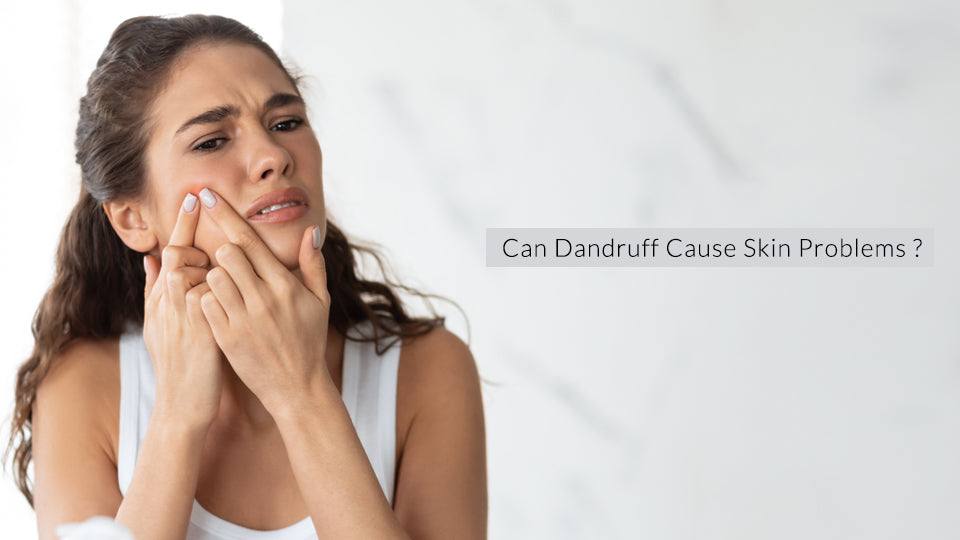Can Dandruff Cause Skin Problems?

Do you have severe itching, flaking, and scaling of the scalp? White flakes and particles on the scalp can be very embarrassing issues to deal with. This is called dandruff in general terms and “Seborrhoeic dermatitis” in clinical medical terms. Let us be honest and truthful about this. This dandruff is clearly visible on our shoulders at the end of the day especially when we wear black clothing. To avoid this embarrassing situation, the majority of dandruff sufferers avoid black clothing.
The problems of dandruff do not just end there. It may go up to a great extent causing skin issues on the face, shoulders, and back. The forehead acne is the most common to judge if you have dandruff. Dandruff can give rise to many skin issues with itching and scaling too.
What is dandruff?
Dandruff or seborrhoeic dermatitis is the affection of the scalp skin which may cause itching, flakiness, and scaling of white dead skin. It is a common skin condition that causes an itchy and scaly scalp. Dandruff in mild form is known as seborrhoeic dermatitis.
What are the signs and symptoms of dandruff?
The common signs and symptoms of dandruff-
- White flakes of dead skin on the scalp and shoulders
- Red crusty raw areas on the scalp
- Itchy and redness of the scalp
- Sore, tender, and inflamed scalp
- White dry or yellow sticky flakes
- Excessive dryness or oiliness of the scalp
- Hairloss and excessive hairfall from the eyebrows
How can dandruff affect the skin?
Dandruff can extend from the scalp to the forehead or may towards the nape of the neck and shoulders. This can lead to -
- Itchy facial skin
- Dryness of skin
- Scaling of the skin
- Redness of skin
- Excessive sebum and oiliness of the skin
- Acne and pimples on the skin
- Severe pustules and boils on the skin
- Eczema or dermatitis of the skin
- Psoriasis of the skin
Dandruff can affect your eyebrows, sides of the ears, or behind the ears. It can spread around temples. It can affect the creases of the nose, side buns, and beard areas. This seborrhoeic dermatitis can spread to the other parts of teh body which can later be difficult to deal with.
Dandruff problems may disrupt the skin cycle causing faster degeneration and regeneration of the skin. The process of the skin cycle is at a faster pace causing flakiness, itching, and scaliness. It is important to control the progression of the skin cycle by breaking the vicious cycle.
Skin is the largest organ of the body. It covers an extensive surface area of not just the scalp but the whole body. When scalp skin is affected, one needs to be careful that there is no extensive or spread of further damage to the facial or body skin.
Facial skin is tender as compared to the body and scalp. Facial skin does not have luscious hair growth as scalp and is more inclined to damage caused by dandruff or seborrhoeic dermatitis.
The skin yeast and skin bacteria lie dormant in the skin. In some cases, excessive dryness or oiliness ( causative factors and triggers) might activate the skin bacteria and yeat causing itching and flaking. Proper control of this bacteria and inhibition of the skin bacteria is important by maintaining a healthy lifestyle and good hygiene.
Who gets affected by dandruff?
Dandruff can occur at any time. Mostly people living in cold climates and winters are easily affected by excessive dryness and flakiness of the scalp. Let us not forget the summers where there is excessive oiliness leading to yellowish sticky flakes.
Teenagers often get affected by dandruff due to hormonal changes. The sudden surge in hormones may result in excessive oiliness of the skin leading to dandruff and acne. Often, this dandruff production is high in teens, especially during puberty.
Dandruff isn't contagious and you cannot catch it for anyone.
What causes dandruff?
The exact cause is not known but the main triggering factors are -
- Too much oiliness of the skin
- Environmental factors like dust, pollution, and climatic changes
- Stress
- Hormonal imbalance especially during puberty and pregnancy
- Eating unhealthy diet
- Consuming oily fried fatty foods
- Using low-quality hair care products
- Using too much heat on hair
- Lack of oil massages
- Excessive production of yeast found on the skin Malassezia
- Too much or too less washing of the skin
- Excessive oiliness of the skin
Eliminate these causes and triggering factors for dandruff to keep the skin healthy from within. Embrace a healthy lifestyle with good hygiene practicess for better skin health of the body, scalp, and face.